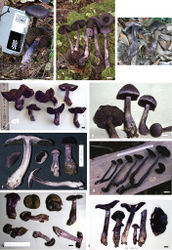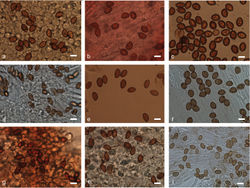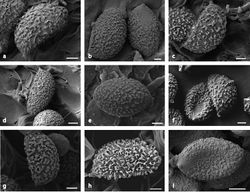Cortinarius hallowellensis
| Notice: | This page is derived from the original publication listed below, whose author(s) should always be credited. Further contributors may edit and improve the content of this page and, consequently, need to be credited as well (see page history). Any assessment of factual correctness requires a careful review of the original article as well as of subsequent contributions.
If you are uncertain whether your planned contribution is correct or not, we suggest that you use the associated discussion page instead of editing the page directly. This page should be cited as follows (rationale):
Citation formats to copy and paste
BibTeX: @article{Harrower2015MycoKeys, RIS/ Endnote: TY - JOUR Wikipedia/ Citizendium: <ref name="Harrower2015MycoKeys">{{Citation See also the citation download page at the journal. |
Ordo: Agaricales
Familia: Cortinariaceae
Genus: Cortinarius
Name
Cortinarius hallowellensis Wood, 2009 – Wikispecies link – Pensoft Profile
Type
AUSTRALIA. Western Australia: Mount Hallowell Reserve, (Eucalyptus) 22 May 1993 K. Syme (holotype: PERTH005506794).
Description
Pileus 34–90 mm wide, not velvety or velvety smooth, not at all squamulose, greasy when wet, radially innately fibrillose when dry, dark violet (18F4), red in 5% KOH. Lamellae broadly adnexed to adnate, 4–9 mm deep, subdistant, dark violet (16F5), edge smooth, entire, lamellulae abundant in 2 tiers. Stipe 37–80 mm long, 10–30 mm thick, dry, longitudinally fibrillose, cylindrical to clavate with a swollen base, 16F4 (dark violet). Universal veil deep violaceus. Context firm in pileus, fibrous in mature stipe, pallid, tinged purplish (16A2) especially near outside; purple slate/deep purple in stipe and middle of pileus surrounded by speckled white in pileus; yellow-brown at base of stipe. Basal mycelium whitish. Odor not distinctive. Taste none.
Basidiospores (8.5–) 10–13.5 µm × (5–) 6–7.5 µm, means = 10–12 µm × 6–7 µm, Q = 1.55–1.95, Q means = 1.55–1.94, (150 spores, 6 specimens), ellipsoid to subamygdaliform, moderately verrucose, plage barely noticeable under SEM. Basidia 4-spored, clavate, (25–) 30–50 (–65) µm × 9–12 µm. Cheilocystidia abundant, narrowly fusiform, purple or brown in KOH, (50–) 55–95 (–130) µm × 10–20 µm. Pleurocystidia abundant, narrowly fusiform, purple or brown in KOH, (40–) 50–90 (–105) µm × (5–) 10–15 µm. Caulocystidia not observed. Pileipellis an ixocutis, of even thickness throughout. Hyphae 2.5–11.0 µm wide. Clamp connections present.
Ecology and distribution
With Eucalyptus, Corymbia, Melaleuca, Allocasuarina, Agonis, and/or Leptospermum in Western Australia and Tasmania. Fruiting May and June.
Other specimens examined
Australia. Tasmania: Scamander, Winifred Curtis Scamander Reserve, near Boundary Track (Allocasuarina verticillata and Eucalyptus), 8 June 2003, D.A. Ratkowsky (MEL 2350466). Hobart, Peter Murrell Nature Reserve. Site HEG. [55G, 524296, 5258469], (Allocasuarina monilifera, Eucalyptus amygdalina, Leptospermum scoparium), 10 July 2001, S. McMullan-Fischer (MEL 2300544). Western Australia: Two Peoples Bay Nature Reserve, Moates Lake access road (Allocasuarina monilifera, Eucalyptus amygdalina, Leptospermum scoparium), 7 May 1991, K. Syme (PERTH 3978729). Cemetery Road near Walpole-Nornalup National Park (Eucalyptus marginata, Corymbia calophylla, Agonis flexuosa, Agonis parvceps, Agonis hypericifolia, Allocasaurina fraseriana, Melaleuca sp.), 3 May 1992, K. Syme, N.L. Bougher & M. Hart (PERTH 7581696).
Discussion
Cortinarius hallowellensis was treated as ‘Cortinarius sp. AU2’ in Harrower et al. (2015)[1]. Based on sequencing the type, we have demonstrated that this species occurs in Tasmania as well as Western Australia. Cortinarius hallowellensis is unique in the Cortinarius violaceus group in that it has an ixocutis instead of a trichoderm and is the deepest diverging lineage in the Cortinarius violaceus clade (Fig. 1). Macroscopically, the pileus is not at all squamulose. The suprapellis is mucilaginous imparting a greasy appearance when wet. The only other species in the Cortinarius violaceus group found in Australia – Cortinarius kioloensis is readily distinguished from Cortinarius hallowellensis by its dry, tomentulose-squamulose pileus. Cortinarius jenolanensis, Cortinarius paraviolaceus and Cortinarius austroviolaceus lack a squamulose pileus, but unlike Cortinarius hallowellensis, they lack pleurocystidia and/or cheilocystidia. Cortinarius hallowellensis is also referred to as Cortinarius violaceus by Bougher and Syme (1998)[2] (PERTH 5506794 illustrated). Unique molecular synapomorphies are found at pos. 63, 100, 101, 123, 132, 148, 163, 164, 180, 228 (ITS1), 462, 532, 540, 546, 577, 602, 611, 614, 643 (ITS2) in our alignment.
Taxon Treatment
- Harrower, E; Bougher, N; Winterbottom, C; Henkel, T; Horak, E; Matheny, P; 2015: New species in Cortinarius section Cortinarius (Agaricales) from the Americas and Australasia MycoKeys, (11): 1-21. doi
Images
|
Other References
- ↑ Harrower E, Bougher N, Henkel T, Horak E, Matheny P (2015) Long-distance dispersal and speciation of Australasian and American species of Cortinarius sect. Cortinarius. Mycologia 107(4): 697–709.
- ↑ Bougher N, Syme K (1998) Fungi of Southern Australia. University of Western Australia Press, 1–391.



